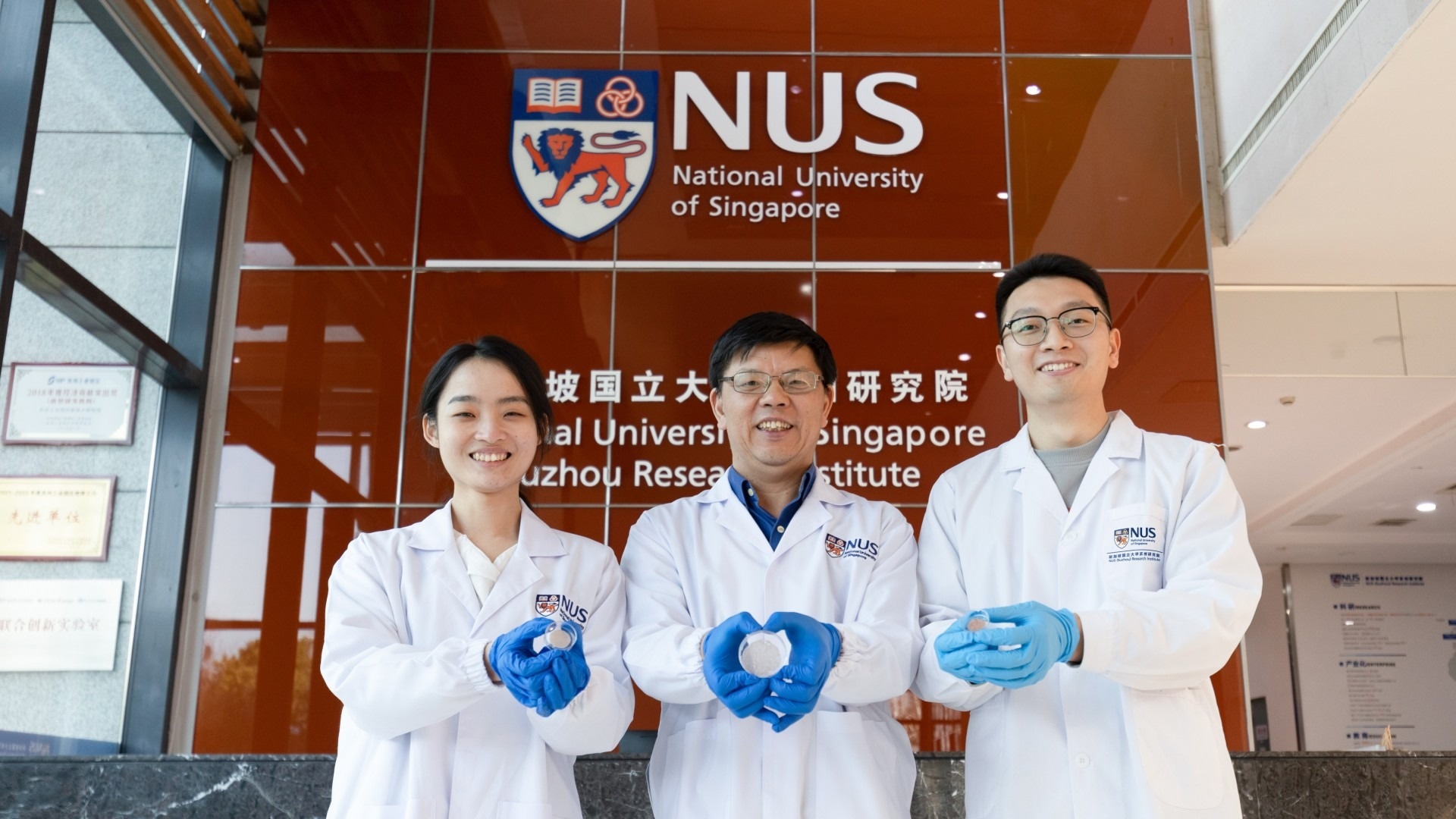The National University of Singapore (NUS) research team has successfully 3D-printed an edible cell culture scaffold using common plant proteins, allowing for more inexpensive and sustainable lab-grown meat to be served on the table.

NUS Professor Huang Dejian (middle) and his research team, which included Ms Su Lingshan (left) and Dr Jing Linzhi (right), developed the plant-based cell culture scaffolds. Image Credit: Temple University
Lab-grown meat, also known as cultured meat or cell-based meat, is becoming an increasingly popular source of dietary protein as people become more concerned about the environmental and ethical implications of their food. Cultured meat is made by collecting skeletal muscle cells from animals and culturing them on scaffolds, which offer structural support while the cells multiply and evolve into tissues.
Cell culture scaffolds, on the other hand, are often built from synthetic or animal-based materials that are either too expensive or inedible. In pursuit of a replacement, the researchers guided by Professor Huang Dejian, Deputy Head of the NUS Department of Food Science and Technology, turned to plant proteins, which are biodegradable and biocompatible with animal cells.
Crucially, plant proteins satisfy conventional food intake needs, making the resulting scaffold suitable for meat culture.
By using readily available cereal prolamins as biomaterials for high-precision 3D printing technology, we open up a new method for manufacturing edible and structured scaffolds to produce cultured muscle meat slices with fibrous qualities.
Huang Dejian, Professor, Deputy Head, Department of Food Science and Technology, National University of Singapore
On October 22nd, 2022, the team’s study was published in the journal Advanced Materials, in keeping with NUS’s mission to create cutting-edge sustainability research.
The Making of an Edible Scaffold
Prolamins are a type of plant storage protein with a low nutritional value due to their specific amino acid profile. Prolamins are really produced as waste in the starch and vegetable oil industries. Nonetheless, Prof Huang and his colleagues used the properties of prolamins to develop an affordable and sustainable resource for meat culture.
The researchers employed prolamin mixes made from corn, barley, and rye flour, also known as zeins, hordeins, and secalins, respectively. These mixes were then used as ink for electrohydrodynamic printing, a high-precision 3D printing process widely used in biomedical applications.
To determine whether the prolamin constructions were suitable for meat cultivation, they were submerged in a cell culture medium and examined seven days later for structural alterations. The scaffolds kept their structure and did not collapse under a scanning electron microscope, despite the fact that many holes developed on their surfaces.
However, the researchers believe that these pores are more likely the result of enzymes secreted by the cultured cells than evidence of structural weakness.
Scaffolds must be biocompatible with muscle cells from agricultural animals to be useful in meat cultivation. This means that they must be able to accommodate these cells and support their growth and development.
Professor Huang and colleagues tested this by seeding the prolamin constructions with stem cells from pig skeletal muscle and measuring cell proliferation over the next few days. They discovered that the cells on the scaffolds divided extensively, reaching a maximum count of 11 days after inoculation. Both zein/hordein and zein/secalin scaffolds generated stem cells comparably well.
Significantly, pig cells seeded onto the prolamin constructs proliferated much faster than pig cells seeded onto a standard polycaprolactone scaffold, a common tool in tissue engineering, illustrating that the plant protein-based scaffold was more viable for cultured meat production than standard synthetic polymers.
Scaffolds made from plant proteins are edible and have diverse and variable peptide sequences that can facilitate cell attachment, induce differentiation, and speed up the growth of meat. In contrast, synthetic scaffolds such as plastic beads used for cultured meat have no functional group which makes it difficult for animal cells to attach and proliferate. In addition, synthetic scaffolds are not edible and extra steps are required to separate the scaffolds from the meat culture.
Huang Dejian, Professor, Deputy Head, Department of Food Science and Technology, National University of Singapore
The researchers attempted to make an actual slice of meat as a proof of concept by culturing pig skin stem cells on a zein/secalin scaffold and then allowing them to differentiate, or mature, into muscle. Beet extract was utilized to approximate the reddish color of the meat.
Their experiment was deemed a success. Within 12 days, the research team was able to culture meat that resembled real animal meat in texture and appearance.
Since the scaffold was edible, no special or additional procedures were needed to extract it from the final product. These results further verify the potential of the proposed prolamin-based scaffolds in cultivated meat production.
Huang Dejian, Professor, Deputy Head, Department of Food Science and Technology, National University of Singapore
Further Developments
Professor Huang and his colleagues are hard at work improving plant protein-based technology. More research is needed, for example, to better understand how the specific structure and composition of the prolamin constructs may influence the growth of animal stem cells and how they form muscle tissue.
“Moreover, we need to ensure the resulting meat products are market-ready, with safety profiles that will satisfy rigorous regulatory demands and nutritional compositions that will fulfill recommended dietary needs. Of course, they need to be appetizing, too. Flavor, aroma, and texture need to be carefully calibrated to compete with traditionally farmed meat products,” says Professor Huang.
Source:
Journal reference:
Su, L., et al. (2022). 3D‐Printed Prolamin Scaffolds for Cell‐Based Meat Culture. Advanced Materials. doi.org/10.1002/adma.202207397.